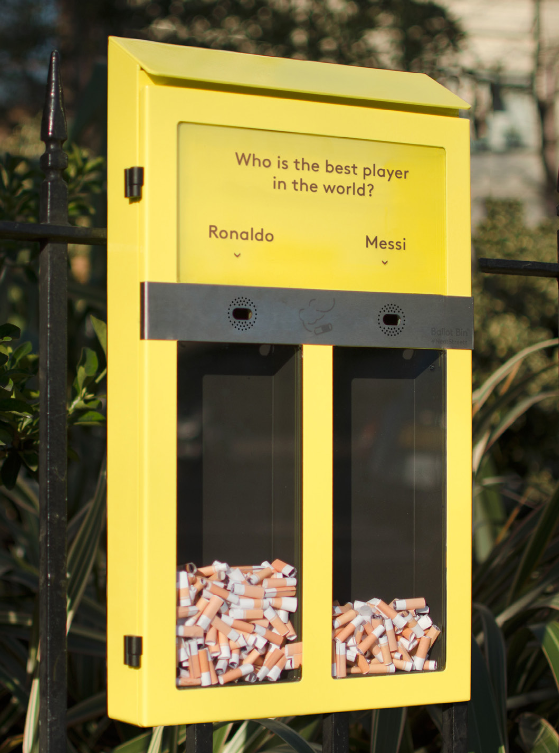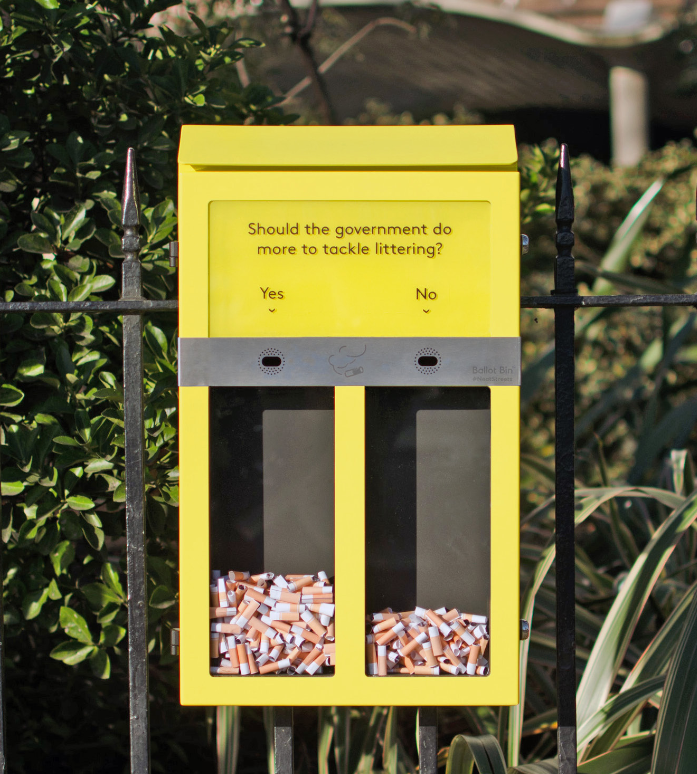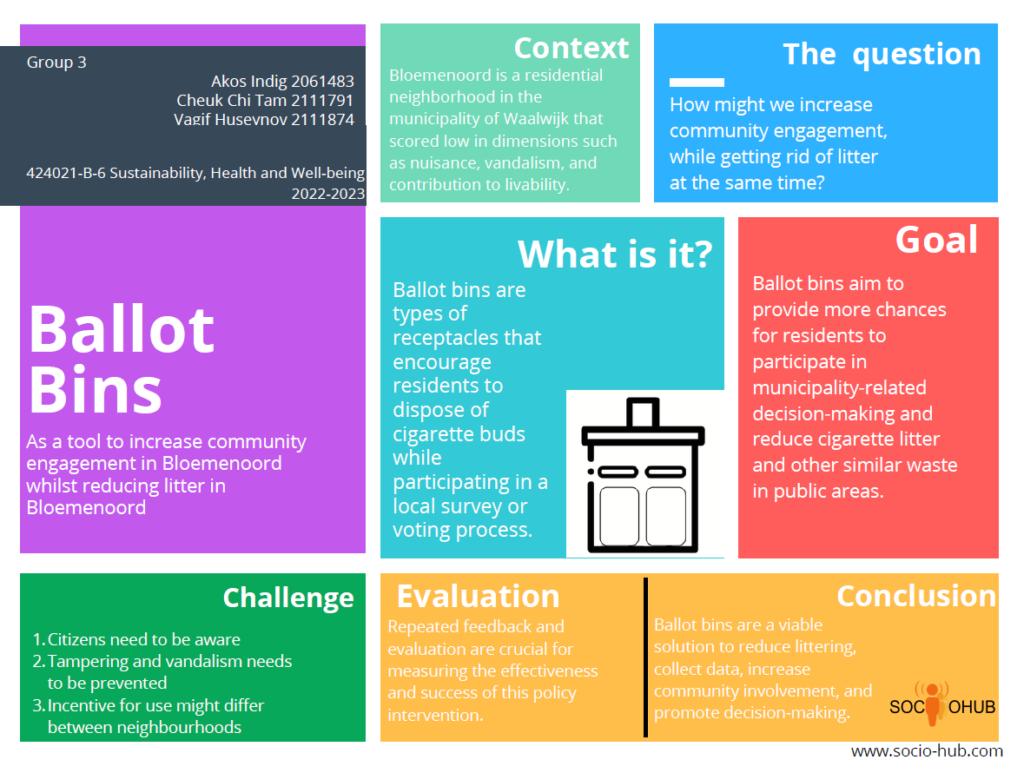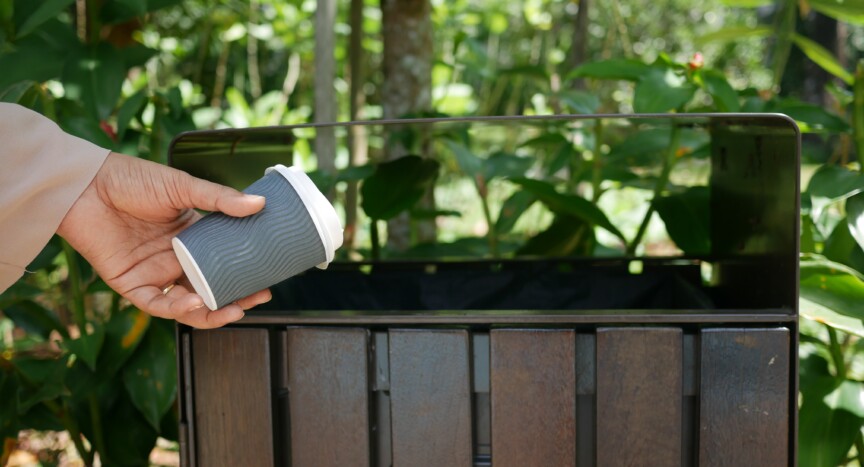A blogpost written by: Ákos Indig, Cheuk Chi Tam & Vagif Huseynov
Introduction
As group 3, we tried thinking of ways to improve the neighborhoods within Waalwijk. As preached in our lectures, happiness, and well-being were our main focus areas, as we believe those are the driving factors behind sustainability and long-term residential happiness. A specific neighborhood with a particular emphasis on social engagement instantly caught our attention: Bloemenoord. Being one of the many neighborhoods found within the municipality, Bloemenoord at first glance did not seem like an area that should have garnered our interest. However, upon closer inspection, we could see how this residential area filled with middle income families was more interesting than expected. Although filled with schools, community centers, grocery stores, and basic utilities, the neighborhood still lacked in certain aspects statistically when compared to those of Waalwijk, namely “Nuisance, Vandalism, and Contribution to Livability.” As a result of a neighborhood survey done by municipality officials,
It was discovered that the main problem behind the either low or no contributions was the lack of opportunities provided to the residents. To tackle this, we tried to adopt some international practices into Bloemenoord in the hopes that a new opening for interaction between residents and the neighborhood and residents could be formed. As a result, we decided to write a policy intervention on ballot bins.

Mechanism Explanation
Ballot bins are types of receptacles that have two primary focuses: collecting cigarette ash and butts while serving as a ballot box for data collection. They are mainly designed to encourage residents to dispose of their cigarette buds, or similar waste, whilst also allowing them to participate in a local survey or voting process. The functionality of the ashtray ballot comes with the existence of different compartments, wherein the waste can later be collected and counted by local authorities or event organizers to make decisions that residents participated in. The idea is to evenly distribute ballot bins throughout Bloemnoord in a bid to provide the neighborhood with more chances to vote and partake in municipality-related decision-making. As a result, Bloemenoord and Waalwijk in general can benefit from the promotion of civic engagement and encouragement of people to participate in the democratic process while also reducing the amount of cigarette litter in public areas.
Desired Outcomes
Throughout this policy intervention, the sought-out outcome is the elevation of happiness and well-being as a direct result of decreases in nuisance and vandalism. Furthermore, increases in residents’ contribution to livability and decision-making are also strived for, as that will lead to smoother and more efficient implementations. In addition to helping in coming up with the optimal distribution of resources, residential involvement can also help with the creation of support for the policies (Rifkin, 2014). With that support, come a myriad of benefits in the forms of better resident and regulator collaboration, increased interaction between neighbors and inhabitants, and a more collectivist environment, which paves the way for a more amicable community.
Challenges & Opportunities

The main obstacle that needs to be overcome during the implementation phase is making sure of the presence of awareness and ensuring the usability of ballot bins. The main way that can be done is through the utilization of social media, community newsletters, and flyers in a bid to better introduce the concept and make sure that the residents are aware of its functionality (Stern, 1999). In addition to that, making sure that no tampering is done with the ballot bin is also a preliminary concern, as users may dispose of more than one cigarette bud in a day, resulting in them having voted more than once and thus interfering with the validity of data collection. If that were to take place, then one of two purposes of ballot bin implementation, surveying, would lose its value.
For the aforementioned issues to be tackled, two steps have to be taken: an apt introduction and on point explanation. In order for ballot bins to be taken seriously and to ensure good reception, the concept as a whole needs to be introduced correctly. Since ballot bins have not been used in the neighborhood and municipality before, the residents may struggle at first with adapting to their presence. To ease their transition, government officials should make sure that the prominence of ballot bins is understood.
Finally, vandalization and deliberate damage to ballot bins is a likely scenario, wherein the expenses incurred by the municipality may end up yielding no return. To avoid all these risks, the implementation and application of ballot bins have to be treated proactively, with the necessary introduction and monitoring being done on a frequent basis.
Conclusion
To sum up, ballot bins are a viable solution to nuisance, vandalism, and low contributions to the livability of the neighborhood, which are dimensions where Bloemenoord scored lower than the average of Waalwijk. Through the even distribution of ballot bins in public spaces of the neighborhood, the municipality provides more opportunities for the residents to partake in decision-making. In addition, ballot bins are a good method of data collection, littering reduction, and community involvement, all of which can eventually pave the way to a happier, more sustainable, and better-off environment.
The infographic of the blogpost

Reference list
Ballotbin. (n.d.). About Ballotbin. Retrieved April 14, 2023, from https://ballotbin.co.uk/about/
Rifkin, S. B. (2014). Examining the links between community participation and health outcomes: A review of the literature. Health Policy and Planning, 29(suppl 2), ii98ii106. https://doi.org/10.1093/heapol/czu076
Stern, P. C. (1999). Information, Incentives, and Proenvironmental Consumer Behavior. Journal of Consumer Policy, 22(4), 461–478. https://doi.org/10.1023/A:1006211709570







